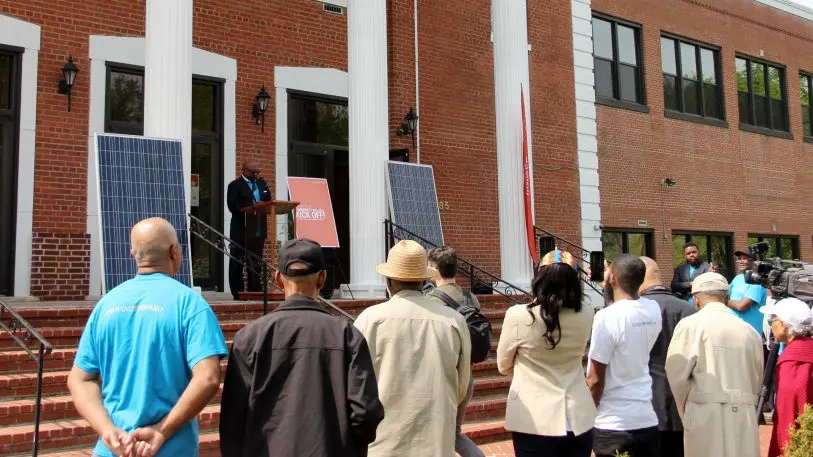When you think of home solar power, you probably imagine a house with solar panels on its roof. But many people aren’t able to access that kind of solar power: maybe they don’t control their roofs, maybe it’s too shady for panels to be effective. Community solar is a solution to this problem: it allows a group of people to subscribe to a larger solar array installed by a provider on a piece of land or property. Every subscriber receives the benefits of solar–namely, a lower energy bill–without the hassle of having to manage the system themselves.
Community solar has grown in popularity in the past several years, nearly quadrupling in capacity since 2016 and generating enough electricity to power around 266,000 households. But despite the feel-good sense around community solar–who doesn’t like the idea of groups of people uniting to collectively support clean energy?–that rhetoric, and the growth its brought about, has largely failed to reach the group that most stands to benefit from solar: low-income communities.
The majority of U.S. community solar projects do not include low-income subscribers, according to a Smart Electric Power Alliance report from 2018. At the same time, low-income households often pay the greatest share of their income, around 10%, toward their energy bills, because their homes often haven’t been upgraded to maximize energy efficiency.
Groundswell, a solar nonprofit based in Washington, D.C. and operating in five other states including Illinois and Maryland, wants to broaden community solar’s reach across the economic spectrum. “Community solar is an opportunity for us to share and do a lot more with solar as it relates to economic development and opportunity,” says CEO Michelle Moore, who served as the federal chief sustainability officer under the Obama administration.
The main issue with low-income access to community solar is how it’s traditionally financed and structured. Community solar developers often treat a subscription like an investment: they ask potential subscribers for credit scores and lock them into long-term contracts. This poses a problem for low-income people, who often lack credit or have low scores. And for renters, being locked into a multiyear contract isn’t usually a smart decision.
“But in fact, community solar projects operate more like a tiny utility,” Moore says. “If a utility were building a new power plant, they would never ask for credit scores or a 10-year contract. You just have to make sure you’re utilizing 100% of the electricity that’s generated.”
Groundswell takes that approach. The nonprofit sources funding from government grants and foundations, like Citi Foundation, and sets up churches and faith-based organizations as the hosts of community solar projects. It’s Groundswell’s responsibility, Moore says, to keep every project fully subscribed, “so the funding providers are looking to us, instead of at the credit score of the people subscribing,” she says. Through Groundswell’s model, which they call Share Power, market-rate customers subscribe to a community solar project for around the same cost that they would pay their conventional utility.
Normally, community solar affords subscribers a discount on their energy bills, but Groundswell’s model is different: it asks market-rate subscribers to forego the discount to collectively support low-income subscribers to be able to access the energy free of charge. For every three to five market-rate households who subscribe, one low-income household will be able to join. “We’ve had good acceptance of that model,” Moore says, because ultimately, the cost is the same to market-rate subscribers, but they get the benefit of supporting both clean energy and economic equity. Groundswell has also created a dashboard that will allow market-rate subscribers to track the impact of their purchases.

Currently, Groundswell is still in “demonstrate” mode, Moore says: Several projects are in the process of getting off the ground, and one project, hosted at the DuPont Park Seventh Day Adventist Church in D.C.’s Ward 7, has broken ground. That project will be 100% subscribed to by low-income customers, because it’s being entirely funded by a grant from D.C. Solar for All, a new $13-million program that will provide funding to projects that aim to help low-income families reduce their energy costs. For that project, Groundswell worked with Brad Boston, a solar contractor in D.C. who runs Suncatch Energy, which trains local people of color, including people returning from prison, in energy installation work.
This type of partnership, Moore says, shows that community solar can be a vehicle for advancing both clean energy and economic equity. “We want other people to learn from us and copy us,” she says.
Groundswell is not alone in this effort. GRID Alternatives, a nonprofit based in Oakland, California, but with a nationwide reach, partners with local utilities and community groups to install shared solar programs and creates jobs for people from underserved communities in the process. In Brooklyn, a new community solar project on the roof of a revamped industrial building will be collectively owned by resident-subscribers of the nearby Sunset Park neighborhood, who will be able to set rates and keep the project affordable. On the Leech Lake Ojibwe reservation in northern Minnesota, where 42% of residents live below the poverty line, a community solar project broke ground in 2017 specifically to help the tribe lower their energy costs. Organizers sourced funding from the federal Low Income Home Energy Assistance Program to build a solar array on tribal lands that sends 50% of the generated energy to local buildings and 50% to the grid. With the money they receive from the local utility company for the clean energy contribution to the grid, the tribe is able to help families with their energy bills.
Projects like these demonstrate that community solar can be a vehicle to create community equity, but those aims need to be built into the project from the beginning—both through using it as an opportunity for job training and career advancement and as a means of enabling people to access affordable clean energy. That involves treating community solar more as a mainstream asset than a private luxury energy option. “Community solar is still so new,” Moore says. But even so, she says, it shouldn’t warrant a financial model that excludes low-income people. “When utilities send out their bills, they don’t expect that people who are lower income won’t pay,” she says. Instead, the expectation should be that everyone can have access to this type of clean energy asset, and it’s up to developers–and more economically privileged community members–to broaden access to those with fewer means.
“When you look at what the growth of the community solar market is projected to be,” Moore says, “we can really build wealth and equity and a much more just local economy through these projects.”
Recognize your brand’s excellence by applying to this year’s Brands That Matter Awards before the early-rate deadline, May 3.
